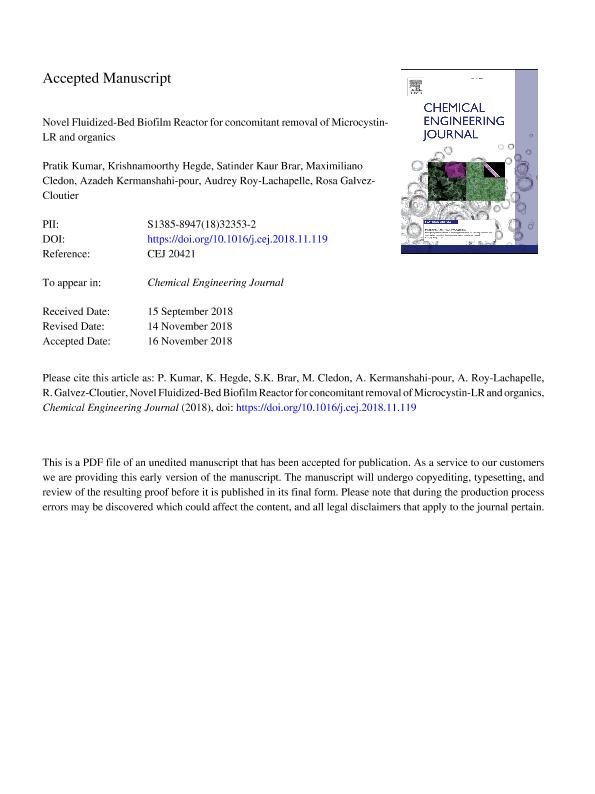Artículo
Novel fluidized-bed biofilm reactor for concomitant removal of microcystin-LR and organics
Kumar, Pratik; Hegde, Krishnamoorthy; Brar, Satinder Kaur; Cledón, Maximiliano ; Kermanshahi pour, Azadeh; Roy Lachapelle, Audrey; Galvez Cloutier, Rosa
; Kermanshahi pour, Azadeh; Roy Lachapelle, Audrey; Galvez Cloutier, Rosa
 ; Kermanshahi pour, Azadeh; Roy Lachapelle, Audrey; Galvez Cloutier, Rosa
; Kermanshahi pour, Azadeh; Roy Lachapelle, Audrey; Galvez Cloutier, Rosa
Fecha de publicación:
03/2019
Editorial:
Elsevier Science SA
Revista:
Chemical Engineering Journal
ISSN:
1385-8947
Idioma:
Inglés
Tipo de recurso:
Artículo publicado
Clasificación temática:
Resumen
Fluidized bed biofilm reactor (FBBR) was evaluated for the removal of microcystin-LR (MC-LR) from drinking water-sludge (0.3% w/v). Biofilm formed inside the solid media carriers (biocarriers) were studied for the MC-LR degradation in FBBRs via known MC-LR degraders: Arthrobacter ramosus (reactor A: RA) and Bacillus sp. (reactor B: RB), along with the heterogeneous bacterial community (HBC) present in the sedimentation-unit sludge as a background matrix. Their ability to form biofilm inside the immobilized biocarriers was periodically quantified for over 300 days to determine the duration of mature biofilm growth, sloughing event and then re-maturation. The bioreactor performance was mainly evaluated in terms of MC-LR, nitrate, nitrite, ammonia removal, and soluble-chemical oxygen demand (s-COD) removal. Biological degradation of MC-LR showed significant role over the physical adsorption, as the removal efficiency increased by around 30% and 26% for RA and RB respectively, as compared to the control bioreactor RD (without any bacterial cells) and an increase by over 15% and 11% when compared to reactor RC (contained only HBC). Mass spectra analysis for RA, RB, and RC strengthen the possibility of a toxic-free degradation mechanism. Overall, RA showed the best MC-LR removal efficiency of around 93.7%, which comprised no MC-LR in the supernatant phase and around 3 µg/L in the sludge-mixture phase. Toxicity assessment of biodegraded sample (using bioindicator) further revealed the toxic-free nature by RA with >80% removal for ammonia, nitrate, and nitrite. Scale-up of laboratory scale FBBR (2 L) is also proposed to handle 200 m3 of feed water per day based on a similar volumetric mass transfer coefficient (kLa) to study the feasible process economics.
Palabras clave:
BIOFILM
,
CYANOTOXIN
,
DRINKING WATER
,
FLUIDIZED-BED REACTOR
,
MICROCYSTIN
,
SCALE-UP
Archivos asociados
Licencia
Identificadores
Colecciones
Articulos(CIMAS)
Articulos de CENTRO DE INVESTIGACION APLICADA Y TRANSFERENCIA TECNOLOGICA EN RECURSOS MARINOS "ALMIRANTE STORNI"
Articulos de CENTRO DE INVESTIGACION APLICADA Y TRANSFERENCIA TECNOLOGICA EN RECURSOS MARINOS "ALMIRANTE STORNI"
Citación
Kumar, Pratik; Hegde, Krishnamoorthy; Brar, Satinder Kaur; Cledón, Maximiliano; Kermanshahi pour, Azadeh; et al.; Novel fluidized-bed biofilm reactor for concomitant removal of microcystin-LR and organics; Elsevier Science SA; Chemical Engineering Journal; 359; 3-2019; 99-111
Compartir
Altmétricas



